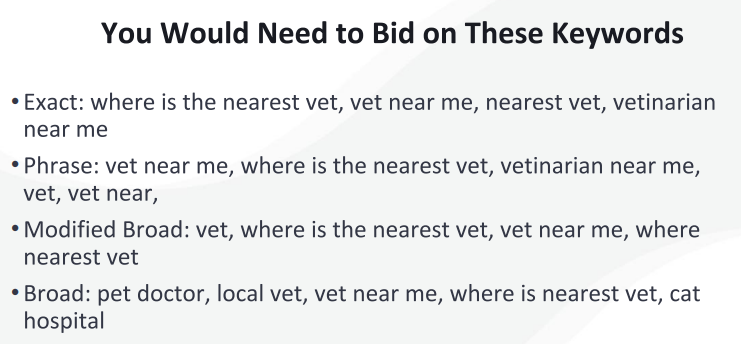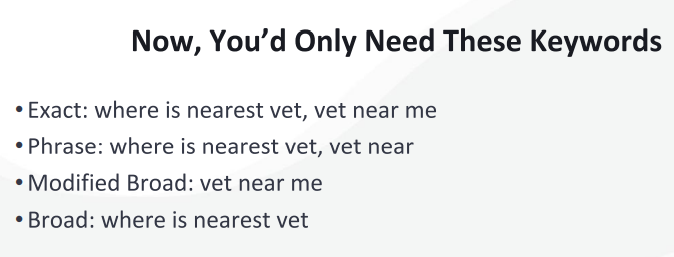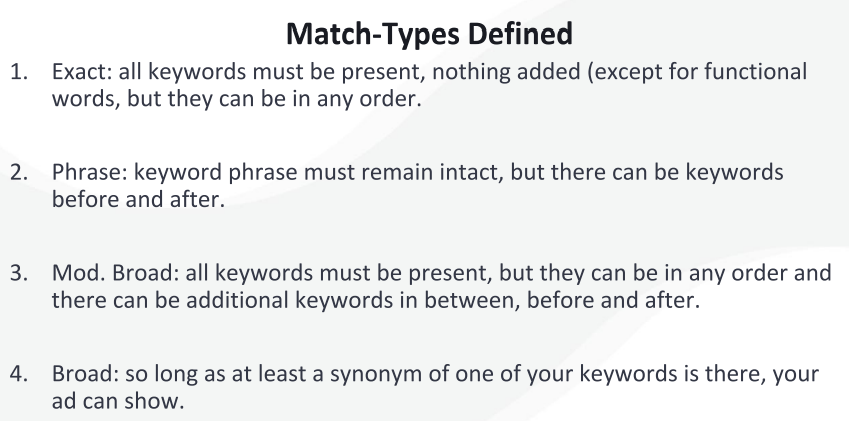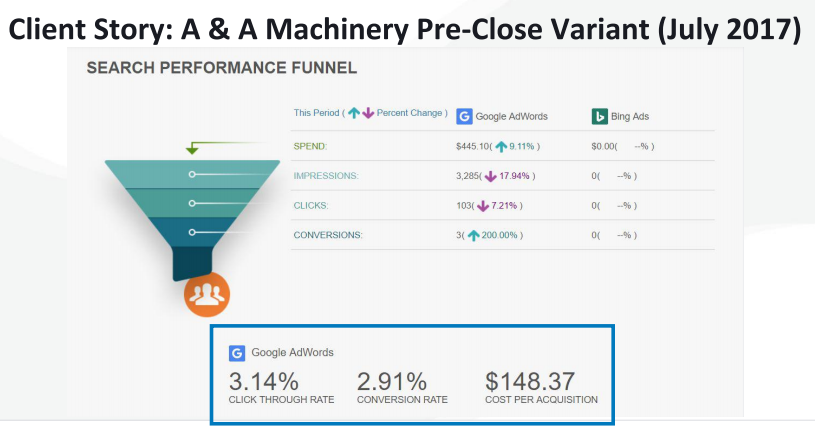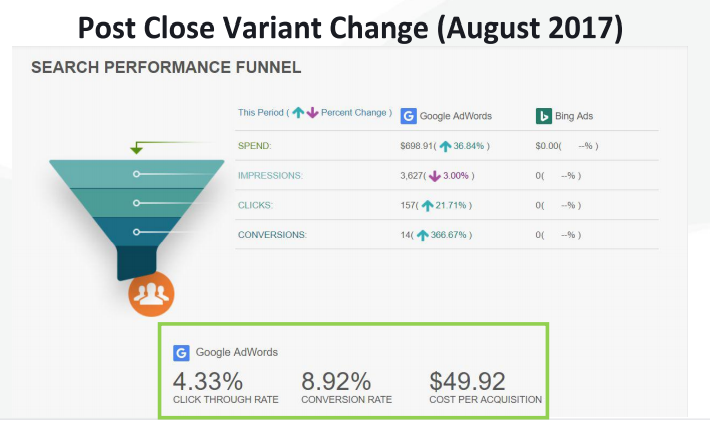Keyword Planning in a Close Variant World
A Guide to Evolving with Google’s Search Marketing Updates: Part 3
Speaker: Navah Hopkins – Services Innovation Strategist at Wordstream
Google introduced close variants as a way to capture plurals, misspellings, typos and other versions of exact match and phrase match keywords. This was intended to broaden reach and coverage and save time building out keyword lists. As search networks advance and evolve, machine learning makes it possible for Google to account for the variants of a keyword, but in the past advertisers had to account for every variation of a keyword.
For example, if you were bidding on the search query {where is the nearest vet}, you would need to bid on all the keywords that you see in the left image below. Using that process caused Ad Groups to grow to massive and unmanageable sizes. With the close variant update that Google uses today, you would only need to bid on the keywords in the right image below. However most advertisers are still configuring their accounts as if Google had not implemented the close variant update and using the structure of the image on the left.
The major issue that stems from continuing to use the old structure is that Google sometimes gets fooled into putting budgets in old keywords that don’t drive results. These terms should have been turned off for being a duplicates and instead focused efforts on the valuable ones that drive results. Since we have not accounted for duplicates, leaving the low performing keyword variants running, those underperforming variants are competing with the high performing/low CPC keyword variants. Thus you are competition against yourself or the duplicate keywords/close variant unknowingly and driving up your Average CPC.
What is a Close Variant?
A variant is one of the following:
- singular/plural forms of a keyword
- different tenses (“ed”,”ing”,”er”)
- abbreviations
- misspellings
- one word turned into two words and vise versa
For example, the following words are all close variants and will be considered the same keyword to Google (on the same match type) : Wholesale = Wholesaler = Wholesaling = Whole Sale = Wholesaled. It’s important to note that match type matters a lot when you’re looking at close variants because different match types don’t compete. For example +whole +sale (the broad match version of the keyword) will not compete with “whole sale” (the phrase match version of the keyword). As you can see from the image below – match type will determine the variants of a keyword.
Identifying Duplicate Keywords and Choosing the Perfect Variant
Now that you have a better understanding of exactly what close variants are and what Google considers a close variant – let’s look at how to identify which variant of a keyword we want to focus on for best results. We want to know which has a history of driving results and how to tell which variants need to be shut off because they are not performing. To determine which keyword variant to focus on these are the three things to consider:
- What is the historical performance of the keyword variant?
- What are the auction prices of the keyword variant?
- What is your human intuition saying?
Historical Metrics
The first thing to look at when analyzing historical data is conversions. If you trust that those conversions are painting an accurate depiction of performance going forward, then that should weigh heavily in your consideration. If you do not trust your conversion data and cannot accurately predict performance of your keywords, take a look at CTRs which can be a great second consideration. If CTR is a major factor in your decision, make sure that you have statistical significance in terms of impressions. If you do not have enough data to reach statistical significance, CTRs can be misleading. The last historical metric to pay attention to is Quality Score, which is great for using as a tiebreaker since it is essentially a “report card”. It can help when deciding between two close keywords, but it should not be a major factor when making your decision. To bring it all together, weighing historical data is a concoction of trusting your data, understanding when to look at a single metric or a combination, and using your human intuition. In the case that they mentioned during the presentation, removing close variants using this process, Wordstream was able to reduce CPAs by 37%.
Auction Prices and Picking Keywords that work with your Budget
The next thing to consider, which is just as important as historical performance, is to look at the auction price or the Top of Page CPC bid of the keyword, so that you can see what to expect in terms of cost if you were to be in the top position. The major thing to consider is that you need to make sure that the keyword you’re considering does not exceed more than 10% of your daily budget. You want to be able to fit in 10 clicks from that keyword a day without taking too much of your daily budget. Make sure to look for bargain keywords that have low a Top Page CPC bid, but do not ignore premium keywords that have a high Top Page CPC bid – maintaining a balance of the two is key meeting the 10 click max rule or 10% max rule. Another thing to consider is whether your audience is going to be viewing this keyword on mobile or desktop. If the audience is searching mostly on mobile you may have to bid for the #1 spot which means paying a higher CPC than you would have to pay if you only had to chase positions 2 or 3 in the scenario that most of the audience is arriving via desktop.
Using Human Instinct
If you’re just starting out or do not have the data to make decisions using the previous strategies, then listening to your human intuition is the best route. Ask yourself these questions:
- How do my customers find you?
- How would YOU search for your product or service?
- Are there keywords that are “close but no cigar” in your account and could be removed?
- What type of keywords are commercial in nature and will trigger Google to show my ad?
- What keyword structures work best for my product or service?
As Google advances its understanding of the intent behind a user’s search query considering the questions above is more important than ever. Keyword structure is important when considering which keywords work best in the type of industry that your business is operating in. Please see the images below for more info on how best to structure your keywords based on your industry.
Revisiting Account Structure and the Secrets to a Healthy Campaigns
Before implementing your findings, it’s important to revisit account structures and see what steps you need to take in order to position your accounts for success in a close variant world. The days of an accounts having over 20 Ad Groups per campaign and 90+ keywords in an Ad Group are over. Google’s close variant updates and advances in understanding intent mean that advertisers don’t need massive Campaigns and Ad Groups to cover areas that they would have had to account for in the past. In today’s world, healthy campaigns have the following traits:
- No more than 5-7 ad groups
- No more than 5-10 keyword concepts per ad group (including keywords representing the underlying concept and other match types)
- One time zone
- One strategic objective
- 2-3 expanded text ads
- Multiple match types
- Bids that fit within the budget (10 click minimum rule)
Transitioning Your Account and Implementing your Findings
So the next question is: What is the best way to implement our findings and transition your account into a healthy one? After you’ve made sure your account follows the “healthy campaign outline” above and you’ve trimmed off all the fat, then pick one ad group to represent the variants of a keyword – see image below for reference.
After you’ve decided which ad group you’d like to represent the keyword variant, move necessary keywords into the ad group you’ve chosen and pause the redundancies (see image below), so you don’t repeat the issues with close variants you’ve worked so hard to correct.
Make sure you copy campaigns if settings need to be carried over, such as location settings or bids. To put this all-in perspective, take a look at the case study we went over from Wordstream that shows performance Pre-Close Variant analysis vs. Post-Close Variant change.
Case Study: Pre-Close Variant Analysis vs. Post-Close Variant Change
As you can see, Wordstream more than tripled their conversion rate from 2.91% to 8.92% and drastically decreased CPAs from $148 per conversion to $49!
Just to give a little insight on which match types and keywords they decided to implement first, the process they used goes as follows: start with exact and broad mod match types, then start pausing broad mod keywords and replacing them with phrase match and finish it off by adding long tail keywords. In the end, removing duplicate keywords stopped the account from bidding against itself and inflated cost per click, which was ultimately doubled the CPA.
A major point I took away from this topic is that search engines understand human intent, it is more crucial than ever you understand what Google and Bing consider a close variant – which include the following:
- singular/plural forms of a keyword
- different tenses (“ed”,”ing”,”er”)
- abbreviations
- misspellings
- one word turned into two words and vise versa
Another thing to keep in mind is when you’re doing keyword planning, deciding which keyword variant to focus on should be influenced by the following: historical data, auction price, human intuition, and proven keyword structures. It’s really important that you are auditing your accounts and improving account structure according to what we mapped out earlier so your accounts are happy and healthy. Testing is always an important part of any successful campaign so make sure that you are always trying new keyword concepts and testing different ideas to find those diamonds in the rough.

